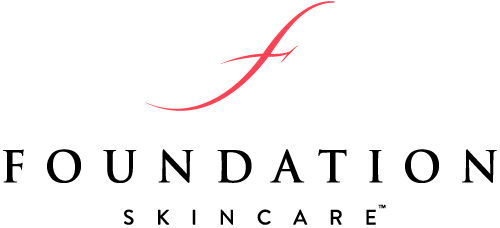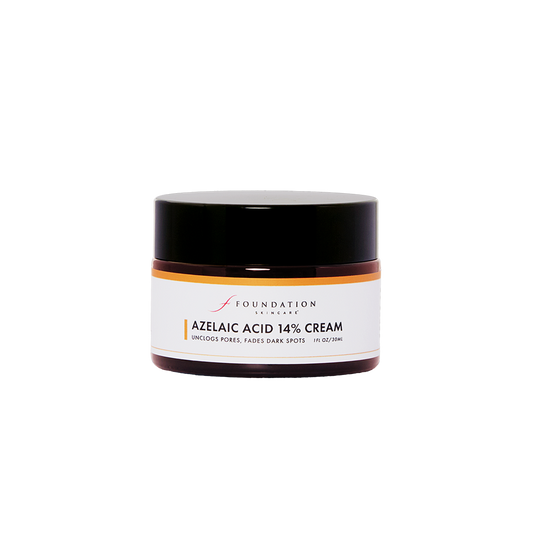Found naturally in grains like wheat, rye, and barley, azelaic acid has become a popular skincare ingredient for its powerful antibacterial and antioxidant properties. Whether you’re struggling with acne, rosacea, hyperpigmentation, or premature aging, azelaic acid cream can make a significant difference, especially with long-term use.
In the past, this catch-all product was only available with a doctor’s prescription. And you still need a prescription for higher concentrations. But you may have also seen lower strength azelaic acid products at your local cosmetic store. Is there a major difference between a prescription and non-prescription product? How do you know which strength to use?
Read on to find out more about azelaic acid benefits, how effective it is at different concentrations, and how to incorporate it into your routine.
What is Azelaic Acid?
Azelaic acid is a naturally occurring dicarboxylic acid with antimicrobial, antioxidant, and anti-inflammatory properties. These qualities make azelaic acid an effective neutralizer of free radicals, which are notorious for triggering acne breakouts, irritation, and inflammation. It also slows the buildup of protein on the skin, which leads to dead skin cells that clog pores.
Azelaic acid functions as a tyrosinase inhibitor, which helps to prevent melanin synthesis. This reduces hyperpigmentation while easing inflammatory conditions like rosacea. The active ingredient also disrupts the connection between testosterone and the body's production of oil, which can be useful in calming hormonal flare-ups.1
When paired with other skin-nourishing ingredients like vitamins C, E, and A, research has shown that azelaic acid may also help to reduce signs of aging like fine lines and wrinkles. In one study, the majority of participants reported an improvement in skin hydration, firmness, and elasticity, a more even skin tone, and a reduction of skin redness and wrinkles. And 100% of participants were satisfied with treatment.2
Benefits of Using Azelaic Acid
Research shows that consistent use with azelaic acid can help:3
- Clear your pores of acne-causing bacteria
- Reduce inflammation and inflammatory conditions like rosacea
- Encourage cell turnover for faster wound and scar healing
- Prevent melanin synthesis to reduce hyperpigmentation and discoloration
- Prevent hormone-related acne breakouts and flare-ups
- Minimizes the appearance of fine lines and wrinkles
Azelaic Acid 14% Cream
• Brightens skin, fades brown spots
• Unclogs pores, improves texture
The Most Effective Percentage of Azelaic Acid
Most prescriptions for azelaic acid contain a 15-20% concentration of the active ingredient. For many, this potency can be irritating and dry out skin, especially if it is sensitive. On the other hand, most over-the-counter products don’t contain more than 10% acid, which may not be sufficient to significantly improve the skin’s condition.
Foundation Skincare’s Azelaic Acid Cream 14% strikes the perfect balance in being effective enough to produce real results without drying out or irritating the skin. Even more, the dermatologist-formulated, medical grade product comes in a moisturizing cream base for extra hydration and gentleness on the skin.
Can You Use Azelaic Acid Every Day?
At the right concentration, it’s absolutely safe to use azelaic acid every day. In fact, some people use Foundation Skincare’s Azelaic Acid Cream twice a day. However, if you have sensitive skin, you may want to build up to using the product over 2-3 weeks to see how your skin responds. Feel free to layer other products with azelaic acid, but use it last in your skincare routine (only before SPF) during your morning application. Unlike other products used for pigmentation (like hydroquinone), azelaic acid will not make your skin more sensitive to the sun.
When using azelaic acid, it’s important to remember that consistency is key and it will take some time to see its full effects. After 6-8 weeks,
you may notice less redness and a softer feel to your skin with fewer flare-ups. After 90 days, your skin conditions should be under control with skin texture, brightness, and hyperpigmentation significantly improved.
How To Incorporate Azelaic Acid Into Your Routine
Here’s how to incorporate Foundation Skincare’s Azelaic Acid into your routine:
- Cleanse with a mild cleanser and pat dry
- Apply moisturizer or any other serums you may be using; the product pairs with Niacinamide Lotion 10% to further reduce hyperpigmentation, Vitamin C Lotion 20% for more firmness, elasticity, and brightening effects, and Hyaluronic Acid Lotion for extra hydration
- Use a pea-sized amount of azelaic acid and gently apply a thin layer to your entire face
- Avoid getting the product in your eyes, lips, and mouth
- Follow up with sunscreen with an SPF of 30 or higher (in the day)
- If you’re using at night, consider adding Foundation Skincare’s Night Renewal Cream with 2% Granactive™ Retinoid to further encourage collagen synthesis and brighten uneven skin
When using azelaic acid to provide topical support to the skin, you can attain even more powerful results faster by adding a nutritional supplement to your routine. Foundation Skincare’s Spectrum supplement supports skin renewal and prevents sun damage through plant-based antioxidants and key vitamins like vitamin D and niacinamide. And Foundation Skincare’s Pigmentation Defense helps to further improve visible signs of skin discoloration and pigmentary disorders with its custom blend of antioxidants, vitamins, and herbs. Both of these products enhance your skincare routine from the inside to maximize the effects of any topical products you’re using.
Learn more by browsing the entire Foundation Skincare collection.





